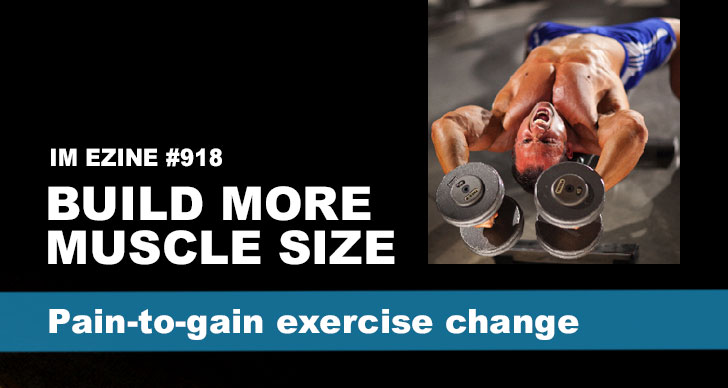Subject:
IRON MAN E-Zine: Issue #277: More Muscle With Static Holds
TABLE OF CONTENTS:
* Try This at Your Next Workout
==========================================
TRY THIS AT YOUR NEXT WORKOUT
==========================================
More Muscle With Static Holds
Q: I’ve been hearing a lot about static-contraction training and how it can build a lot of muscle quickly. Does it really work, and didn’t the guys who started that just take X-Rep partials and turn it into an isometric hold?
A: Let’s start with your second question first. The evolution of end-of-set X-Rep partials was actually the result of our testing static-contraction training. A few years ago a group of articles on isometric, or static, holds came to the IRON MAN offices from three respected authors, one of whom built 21-inch arms doing only about four sets of biceps and triceps work twice a week—no steroids. He said the key to making it happen was compound exercises with a significant twist—holds at the right place along the range of motion (more on that “right place” in the study discussion coming up). The other two training researchers had similar things to say about the anabolic potential of static training.
We had collected a few more pieces of the mass-building puzzle: Our own research showed that trainees stop a regular dynamic set due to nervous system failure—leaving too many muscle fibers understimulated for growth to occur. That’s why most bodybuilders do so many sets—to make up for that nervous system crap out that prevents optimal fiber recruitment. In other words, with normal training you need many successive sets to get at enough fibers for a growth response. Even with a lot of sets, however, stimulation can be insignificant because the nervous system flakes out early on every single effort. That’s why it takes so long to build noticeable muscle for the majority. We were looking for a way to get over that hurdle—to make muscle growth occur faster with less time in the gym…
We asked ourselves if an isometric contraction at the right spot in the range of motion at the end of a regular set could force more nervous system activation, enough to tax many more growth fibers and exponentially increase the muscle-building power of any set. Science and anecdotal evidence say yes—that’s how the author with the 21-inch arms did it—however, our research suggested that small dynamic pulsing actions may work better. The reason is because the nervous system needs some movement for optimal response, even if that movement is small. We tested those “X Reps,” meaning reps that “extend” a set, and after only one month our suspicions were verified—we had made our best gains ever [the program we used during that 30 days is outlined and explained in The Ultimate Mass Workout e-book, along with the research behind it]…

All of that doesn’t mean static holds aren’t effective. In fact a 30-to-60-second stand-alone hold sets provide an incredibly deep ache, signifying unique and/or new fiber activation. We discuss that in our X-Rep Update #1 e-book, but we suggest using that technique in conjunction with full-range sets and X-Rep partials as well as to get optimal growth-fiber stimulation from a number of pathways.
An interesting study that Steve wrote about in his first book, IRON MAN’s Home Gym Handbook, verifies not only the effectiveness of static-hold training, but that using a contraction at the semi-stretch point, or X Spot, is ideal…
The study appeared in the Journal of Applied Physiology (Vol. 64, No. 4, 1988) and involved three groups of men working out for five weeks. Group 1 trained their biceps isometrically at 25 degrees (0 degrees is full extension, so this is the semistretch point, or X Spot), group 2 trained their biceps isometrically at 80 degrees (just below the halfway point), and group 3 trained their biceps isometrically at 120 degrees (near full contraction).
Results: All subjects showed strength increases throughout the range of motion—not just in the position trained. The group that got the highest increase throughout the range of motion was group 1, the group that trained the isometric contraction closest to full extension, or the X-Spot group. As we’ve said in all of our e-books, the X Spot is the semistretch position, the point along the stroke where the most fiber activation occurs, such as near the bottom of an incline press or chinup, where the target muscle is almost fully elongated. That’s why it’s the best place to perform X-Rep partials or a Static X at the end of a set.
In X-Rep Update #1, we hammer out a plan: Use X-Rep partials and/or a Static X on the big midrange exercises, like chins, incline presses, standing curls, etc.—you pulse or hold in the semistretch position (as in the study).

If you use X-Rep partials and/or a Static X in the semistretch point on your big midrange exercise, we suggest a different spot on contracted-positions exercises, like leg extensions, leg curls, concentration curls, cable crossovers, etc. We call it StatC, which is a static hold in the flexed position—where you can squeeze the target muscle.

On stretch-position exercises, like dumbbell flyes, incline curls, overhead triceps extensions, etc., you use StatS, which is a static hold in the stretch position—where the target muscle is elongated. That mimicks the tactic used in the animal study we discuss in our e-books that got a 300 percent muscle-mass increase in only one month with progressive stretch overload.

That combination gives you growth-fiber activation in the key positions for size stimulation along different pathways. It’s efficiency-of-effort muscle building to help you build the most mass fast with the shorter, less recovery-draining workouts. [The X-Rep program on pages 35-40 in the X-Rep Update #1 e-book contains X Reps, StatC and StatS on the appropriate exercises for each bodypart—midrange, stretch and contracted.]
Till next time, train hard.
—Steve Holman and Jonathan Lawson
www.X-Rep.com
Click on the e-books for more information:
Newbies: If you’re a beginning bodybuilder, coming back from a layoff or a trainer who trains beginners, our new e-book, Quick-Start Muscle-Building Guide, is for you.
For any questions or comments regarding the IRON MAN Magazine Online Newsletter, please email [email protected]. To unsubscribe, please see the instructions at the bottom of this email.
To follow the ITRC training program in “Train, Eat, Grow,” get a copy of the latest issue of IRON MAN.
——————————————————————–
This Special Report was submitted by Jonathan Lawson and Steve Holman.
The IRON MAN Training & Research Team
The ITRC Training Newsletter is not intended as training advice for everyone. You must consult your physician before beginning any diet or training program. You may forward this email to as many friends as you want, but do not photocopy or reprint this report in any format without the written permission of the copyright holder.
——————————————————————–
Help us build the IRON MAN Research Team — Tell a friend! If you know someone who would benefit from Supplement Updates, Diet Tips and Freebies, forward them this e-zine or tell them to visit us at
http://www.ironmanmagazine.com and click on FREE Training Newsletter.
*We DO NOT sell any subscriber e-mail addresses.
——————————————————————–
*If someone has signed you up for this free newsletter without your permission, or you have changed your mind and don’t want to receive it after all, you can click on the link at the bottom of this e-mail to unsubscribe.
Visit the Home Gym Warehouse online store for the latest books, videos and equipment specials at
http://www.home-gym.com
All Content (c) Copyright 2009 IRON MAN Magazine
All Rights Reserved















You must be logged in to post a comment Login